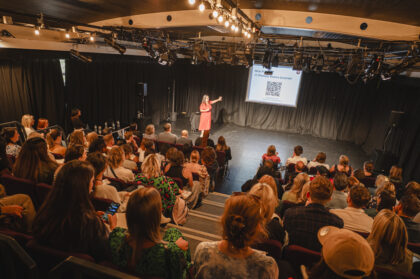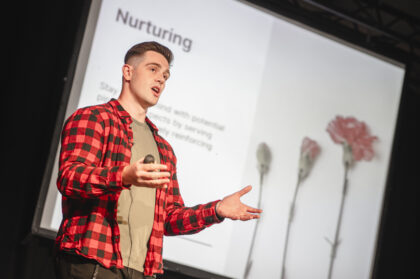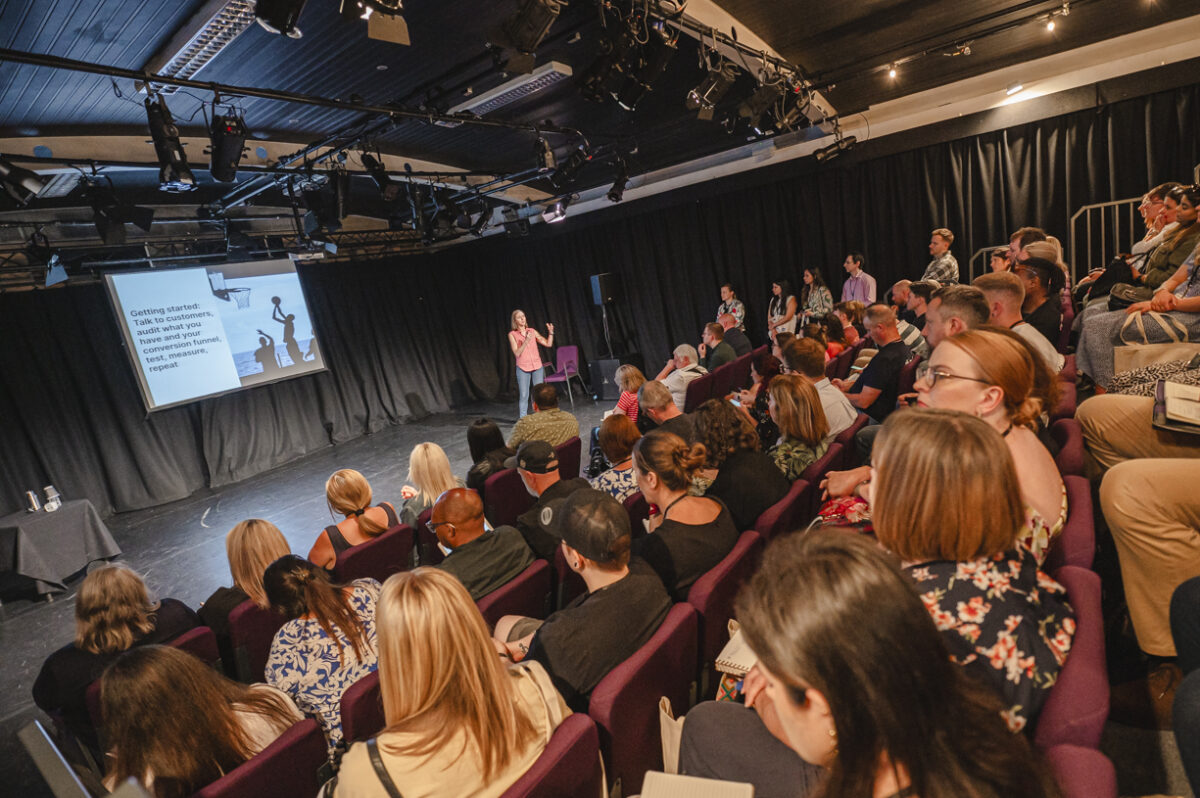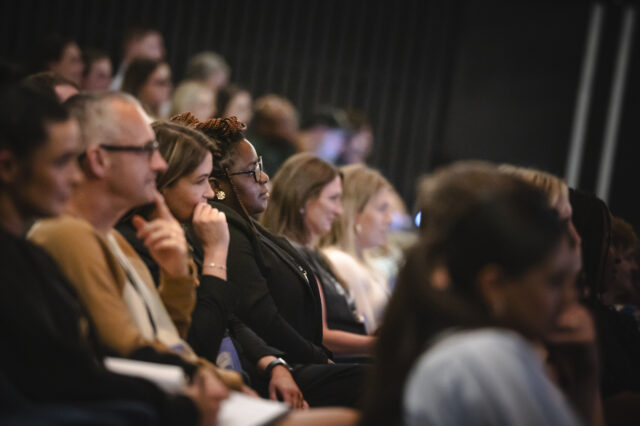At this year’s Nottingham Digital Summit, there were four core themes present across the talks in the Neville Studio: AI, creativity, the importance of measurement, and evolving customer experience and attitudes.
Co-written by Nottingham Trent University Masters student, Eimhear Downey, here’s our top takeaways from across all of 2023’s Neville Studio talks.
AI
AI – and, more specifically, ChatGPT – was the topic of conversation across many talks in the Neville studio. Its ability to simultaneously help and hinder businesses by generating high-quality content at high speeds, but often in an inauthentic way, was explored across a number of talks.
Creative Copywriter, Mel Barfield, discussed the use of generative AI and its problems in creative copywriting. Generative AI – in the form of ChatGPT – is, by definition, formulaic. It knows which word is likely to come after another and provides content based on that. Mel argued that people are beginning to tune out from the generic, formulaic language that is created by ChatGPT and this is why she feels that human expertise will always win. Only a human is able to add in a non-formulaic, clever twist, which is what ultimately helps brands to stand out from the noise when it comes to copy.

Founder of Made with Intent and author of ‘The Person in Personalisation’, David Mannheim, discussed the future of marketing in his session, predicting that personalisation isn’t going away, but will improve. He claimed that power will shift back to the consumer and towards resonance, moving away from AI tools and what they are programmed to think is relevant to the consumer.
Alan Gormley, CEO of Shopbox AI, highlighted how Shopbox has already begun to shift towards resonance, allowing users to take the next step and personalise their own journey with options such as ‘More like this’ when viewing products on ecommerce sites.
Creativity
Both large and small brands’ creative teams can struggle with capturing creative and innovative ideas when dealing with financial restrictions. However, creatives are not something that should be dismissed, especially in a digital world filled with so much noise.
Sarah Fleming, founder of First Create, outlined her ‘Ten Creative Commandments’ for enhancing brand outreach while keeping your audience in mind. These involve making sure your angle is creative but based on a concrete understanding, and that your story is on-brand and relevant to your audience.
Our key takeaways were:
- Create a unique perspective on a story with a trending topic – combining the use of data and creativity will entice your audience.
- Make sure to diversify your ideation tactics, whether that’s through mind-mapping, collating ideas from your team etc.
- Use an outline document for planning key angles 1 week before launch.
- Remember, looking at things from a different angle can blossom creativity and prevent writer’s block.
Julie Reid, Hallam’s Strategy Director, touched on the importance of creative assets when it comes to return on investment (ROI) on your paid activity, particularly in a time of economic uncertainty.
Her most important takeaways were to ensure the language and tone of your creative assets reflect your customer’s reality, tapping into what’s going on in your customers’ lives so that your paid activity resonates, connects and moves them to action.
She also touched on the growing importance of creative assets now that privacy is increasing; Julie argued that we no longer have the same level of targeting data to push our ads to the right people at the right time on the right channels (if that was ever a reality!), so now, we need to ensure our creatives do the job of capturing the attention of the right customer, filtering out the people who aren’t the right match or if it’s not the right time, and getting them to take action.
One way of increasing creativity among teams is by making sure you hire the right people. Tim Dixon, Managing Partner of Beagle Talent, shared the best tactics for recruiting and building better teams:
- Build a talent ecosystem
- Investigate skill pools
- Develop a talent tribe – what do each of your work ‘tribes’ need?
- Create utility relationships
The importance of measurement
In an ideal world, the consumer journey would be a simple line from first exposure to purchase, with no bumps in the road. But, unfortunately, things aren’t so straightforward. As consumers ourselves, we all know there are many factors that can sway a purchase decision, some even being totally out of your brand’s control.
Julie also explained the importance of measuring full-funnel metrics to give us the data we need to make better decisions around strategies, investments and tactics in her talk.
Getting the foundational elements right will determine the usefulness of your data, such as understanding the customer journey and drop-off rates at each stage:
- Awareness: the impact of your marketing on the minds of the customer. You can measure this through annual brand surveys, with share of search and brand clicks.
- Exploration / evaluation: the behaviours and actions customers take. At this stage you should measure website traffic from both new and returning audiences, engagement with any ads or on site – cost per click, cost per lead, event interactions and audience building – emails, social followers, etc.
- Conversion: this is about the sale at the end of the day – an e-commerce transaction or closed-won deals. You can also include some interim steps here like account registration, requesting more information, app installs and engagement, lead breakdown by channel, sales qualified leads and opportunities taken forward.
Joy Talbot and Hal Webb, econometricians at magic numbers, described how to measure each point of attribution throughout the customer journey using a blended approach that combines attribution data with media mix modelling (also known as econometrics) in order to truly understand which influences are driving growth and playing a part in leading the customer to purchase. This way, it becomes much clearer which areas you should be investing in.
The first step is to measure how sales change with the changing of different variables. For example, if you run an ice cream shop, measure how sales have changed since opening up more stores, how sales have changed with temperature changes, how sales have changed with media spend and so on. As you enhance the model by including additional variables, the accuracy of sales predictions improves, allowing you to see where it’s most beneficial to invest.
Jack Brown, Hallam’s Head of Paid Media, explained that in order to get the best results from paid media activity, you must test and measure activity properly – this means running activity for a few months with a fair amount of budget behind it so that you can really see what works and what doesn’t.
He also spoke about the importance of remarketing and the effectiveness of showing returning visitors different ads and copy to the ones they originally saw. Remarketed users are 161% more likely to convert than new visitors, so it’s certainly not an opportunity worth missing.
Overall, Jack urged paid marketers to stop focusing too much on “vanity metrics” like CPA and ROAS, and to start looking at the bigger picture by tracking lifetime value and customer retention rate (CRR).
Customer experience and attitudes
Head of Marketing at Leadoo, Greg Landon, explored the ways in which people are changing how they search, with only 25% – 70% of users actually clicking through to a website after typing a search query into Google. A number of factors are influencing this change in behaviour, but ultimately, it’s more important than ever to make every visit to your website count.
A successful paid social strategy will help build awareness, drive visitors to your site, and push conversions. Building the right strategy requires an understanding of who your customers are, where you can find them, and how they behave.
Alex Jackson, Paid Media Team Lead at Hallam, shared his main pieces of advice for reaching a B2B audience, both nationally and internationally:
- Build data, drive awareness, and push for sales
- Always do your research on competitors and new markets – for example, your UK audience might be on LinkedIn, but can you confidently say the same for a German audience?
- Take the time to tailor your creatives, and languages, for your target audiences
- Don’t rely solely on paid media!

Digital Marketing Lead and Podcast Host of Hear Me Out [CC], Ahmed Khalifa, detailed the importance of real closed captions for creating an enhanced customer experience that appeals to a more diverse set of audiences.
The benefits include:
- Better user engagement and experience
- Improved SEO on Youtube
- It caters to those who don’t speak the language the video’s primary language
- Provides a better experience for those with hearing problems and learning difficulties
In his talk, Brand Consultant, Matt Davies, discussed that while marketers can attract consumers through useful insights, the audience themselves ultimately decide whether your business has a meaningful proposition. The integration of business’s brand position, brand image, and brand values in a world of increasing competition is a necessity rather than an option.
In order to be successful in a time where your customers have so many options you need to prove that you are the only business within a certain market that can provide a specific benefit.
The final talk of the day in the Neville Studio came from Freelance Ecommerce Consultant, Louis Smith, who explored how to create a winning UX (user experience) strategy, which in turn improves SEO and increases conversions.
Our main takeaways were to:
- Research search intent – what kind of things are users searching for in your market?
- Provide the answers to search intent on your website
- Slice your page using headers, sections, and images, so that the information is as clear as possible for Google to understand
- Use the free data that Google provides – e.g. look at People Also AskInterested in more insights? Read our key takeaways from the Main Stage here.







